Factors Influencing Self-Esteem in Adolescence: Education Studies
VerifiedAdded on 2021/04/19
|19
|5601
|26
Essay
AI Summary
This essay examines the multifaceted aspects of self-esteem during adolescence, a critical developmental period. It explores factors like personal appearance, social environment, and performance that can either elevate or diminish self-esteem. The essay delves into the potential consequences of low self-esteem, including reduced happiness, self-destructive tendencies, and social challenges. Furthermore, it emphasizes the crucial role teachers play in fostering positive self-esteem, suggesting strategies such as creating supportive classroom environments and providing counseling. The essay underscores the importance of understanding and addressing self-esteem issues to promote healthy adolescent development.

Running head: EDUCATION STUDIES
Education Studies
Name of the student:
Name of the university:
Author note:
Education Studies
Name of the student:
Name of the university:
Author note:
Paraphrase This Document
Need a fresh take? Get an instant paraphrase of this document with our AI Paraphraser
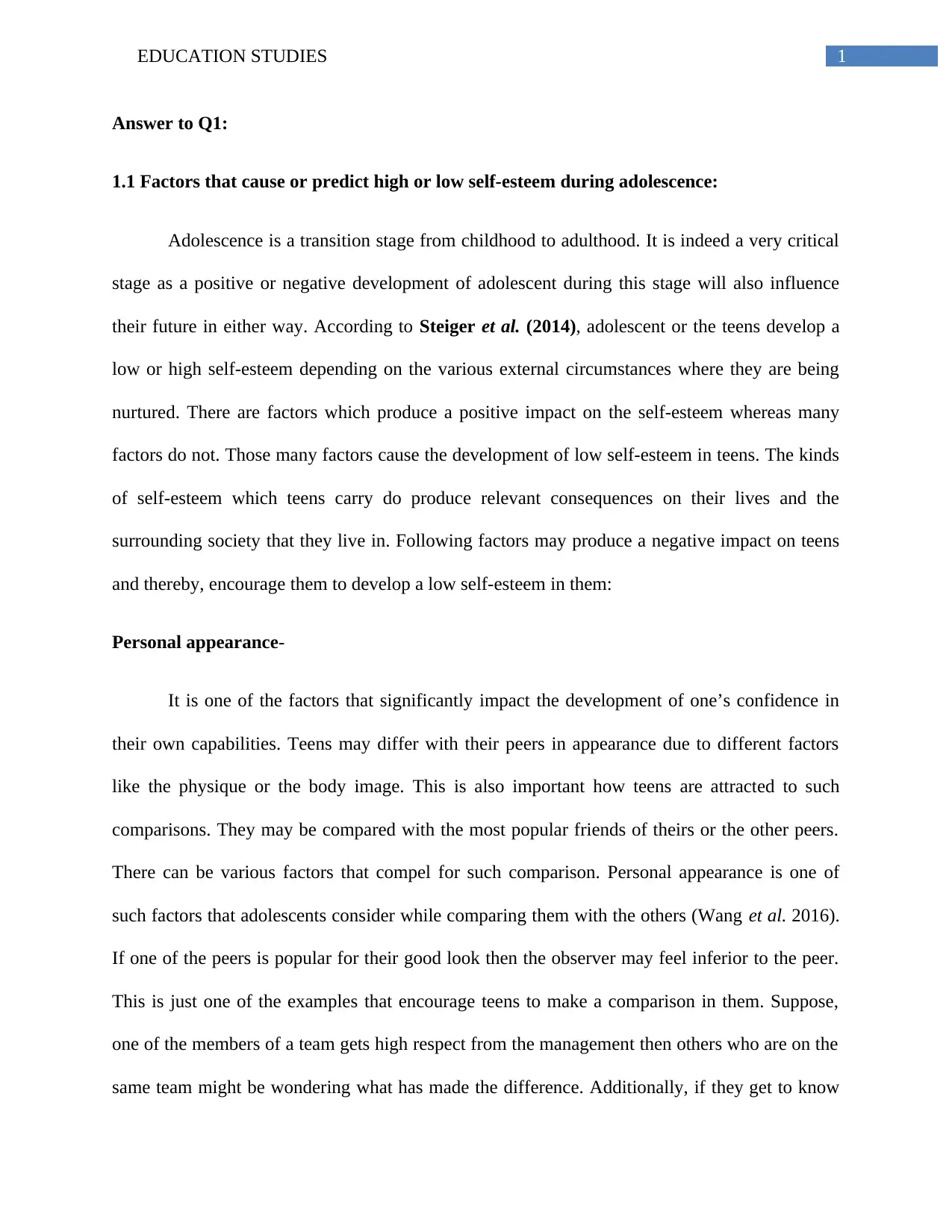
1EDUCATION STUDIES
Answer to Q1:
1.1 Factors that cause or predict high or low self-esteem during adolescence:
Adolescence is a transition stage from childhood to adulthood. It is indeed a very critical
stage as a positive or negative development of adolescent during this stage will also influence
their future in either way. According to Steiger et al. (2014), adolescent or the teens develop a
low or high self-esteem depending on the various external circumstances where they are being
nurtured. There are factors which produce a positive impact on the self-esteem whereas many
factors do not. Those many factors cause the development of low self-esteem in teens. The kinds
of self-esteem which teens carry do produce relevant consequences on their lives and the
surrounding society that they live in. Following factors may produce a negative impact on teens
and thereby, encourage them to develop a low self-esteem in them:
Personal appearance-
It is one of the factors that significantly impact the development of one’s confidence in
their own capabilities. Teens may differ with their peers in appearance due to different factors
like the physique or the body image. This is also important how teens are attracted to such
comparisons. They may be compared with the most popular friends of theirs or the other peers.
There can be various factors that compel for such comparison. Personal appearance is one of
such factors that adolescents consider while comparing them with the others (Wang et al. 2016).
If one of the peers is popular for their good look then the observer may feel inferior to the peer.
This is just one of the examples that encourage teens to make a comparison in them. Suppose,
one of the members of a team gets high respect from the management then others who are on the
same team might be wondering what has made the difference. Additionally, if they get to know
Answer to Q1:
1.1 Factors that cause or predict high or low self-esteem during adolescence:
Adolescence is a transition stage from childhood to adulthood. It is indeed a very critical
stage as a positive or negative development of adolescent during this stage will also influence
their future in either way. According to Steiger et al. (2014), adolescent or the teens develop a
low or high self-esteem depending on the various external circumstances where they are being
nurtured. There are factors which produce a positive impact on the self-esteem whereas many
factors do not. Those many factors cause the development of low self-esteem in teens. The kinds
of self-esteem which teens carry do produce relevant consequences on their lives and the
surrounding society that they live in. Following factors may produce a negative impact on teens
and thereby, encourage them to develop a low self-esteem in them:
Personal appearance-
It is one of the factors that significantly impact the development of one’s confidence in
their own capabilities. Teens may differ with their peers in appearance due to different factors
like the physique or the body image. This is also important how teens are attracted to such
comparisons. They may be compared with the most popular friends of theirs or the other peers.
There can be various factors that compel for such comparison. Personal appearance is one of
such factors that adolescents consider while comparing them with the others (Wang et al. 2016).
If one of the peers is popular for their good look then the observer may feel inferior to the peer.
This is just one of the examples that encourage teens to make a comparison in them. Suppose,
one of the members of a team gets high respect from the management then others who are on the
same team might be wondering what has made the difference. Additionally, if they get to know
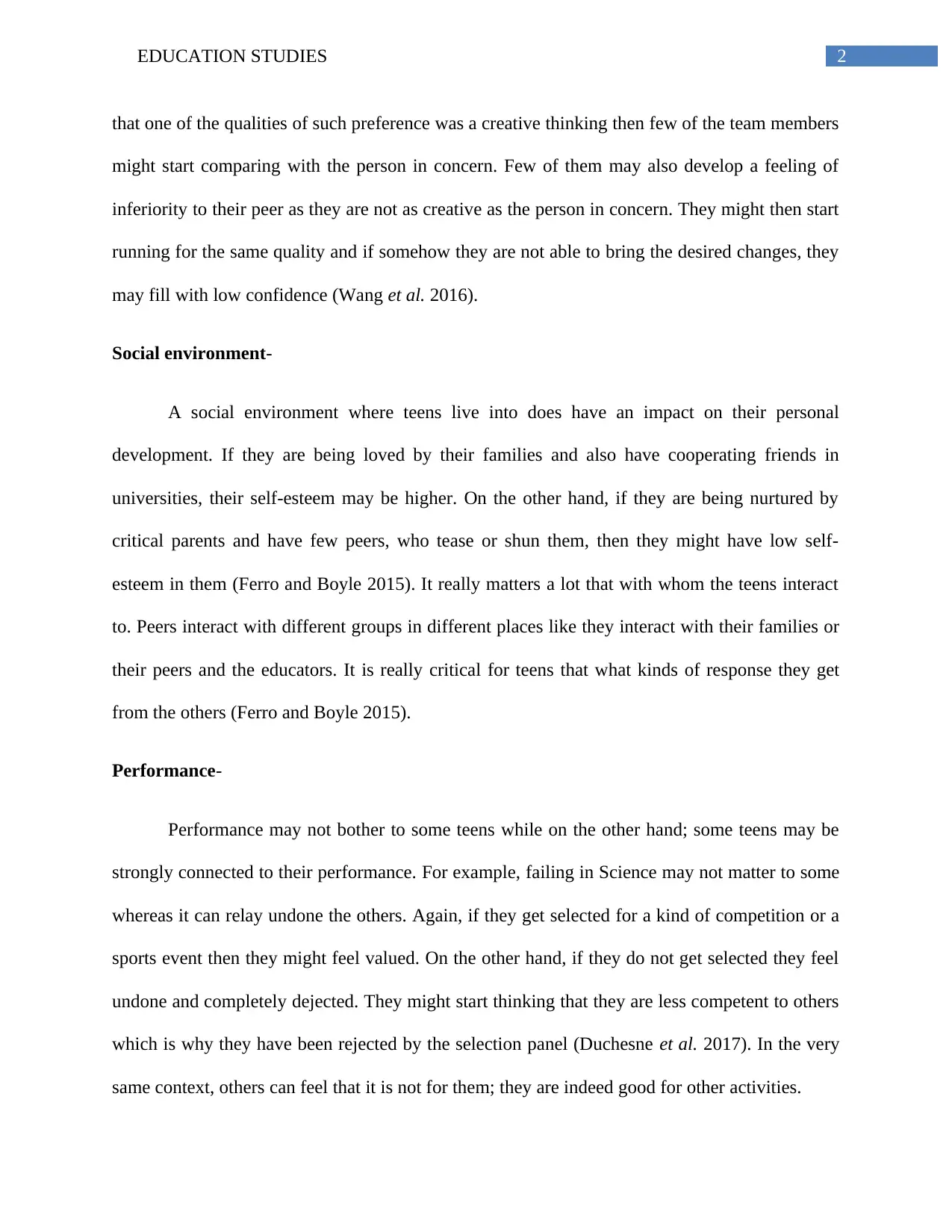
2EDUCATION STUDIES
that one of the qualities of such preference was a creative thinking then few of the team members
might start comparing with the person in concern. Few of them may also develop a feeling of
inferiority to their peer as they are not as creative as the person in concern. They might then start
running for the same quality and if somehow they are not able to bring the desired changes, they
may fill with low confidence (Wang et al. 2016).
Social environment-
A social environment where teens live into does have an impact on their personal
development. If they are being loved by their families and also have cooperating friends in
universities, their self-esteem may be higher. On the other hand, if they are being nurtured by
critical parents and have few peers, who tease or shun them, then they might have low self-
esteem in them (Ferro and Boyle 2015). It really matters a lot that with whom the teens interact
to. Peers interact with different groups in different places like they interact with their families or
their peers and the educators. It is really critical for teens that what kinds of response they get
from the others (Ferro and Boyle 2015).
Performance-
Performance may not bother to some teens while on the other hand; some teens may be
strongly connected to their performance. For example, failing in Science may not matter to some
whereas it can relay undone the others. Again, if they get selected for a kind of competition or a
sports event then they might feel valued. On the other hand, if they do not get selected they feel
undone and completely dejected. They might start thinking that they are less competent to others
which is why they have been rejected by the selection panel (Duchesne et al. 2017). In the very
same context, others can feel that it is not for them; they are indeed good for other activities.
that one of the qualities of such preference was a creative thinking then few of the team members
might start comparing with the person in concern. Few of them may also develop a feeling of
inferiority to their peer as they are not as creative as the person in concern. They might then start
running for the same quality and if somehow they are not able to bring the desired changes, they
may fill with low confidence (Wang et al. 2016).
Social environment-
A social environment where teens live into does have an impact on their personal
development. If they are being loved by their families and also have cooperating friends in
universities, their self-esteem may be higher. On the other hand, if they are being nurtured by
critical parents and have few peers, who tease or shun them, then they might have low self-
esteem in them (Ferro and Boyle 2015). It really matters a lot that with whom the teens interact
to. Peers interact with different groups in different places like they interact with their families or
their peers and the educators. It is really critical for teens that what kinds of response they get
from the others (Ferro and Boyle 2015).
Performance-
Performance may not bother to some teens while on the other hand; some teens may be
strongly connected to their performance. For example, failing in Science may not matter to some
whereas it can relay undone the others. Again, if they get selected for a kind of competition or a
sports event then they might feel valued. On the other hand, if they do not get selected they feel
undone and completely dejected. They might start thinking that they are less competent to others
which is why they have been rejected by the selection panel (Duchesne et al. 2017). In the very
same context, others can feel that it is not for them; they are indeed good for other activities.
⊘ This is a preview!⊘
Do you want full access?
Subscribe today to unlock all pages.

Trusted by 1+ million students worldwide
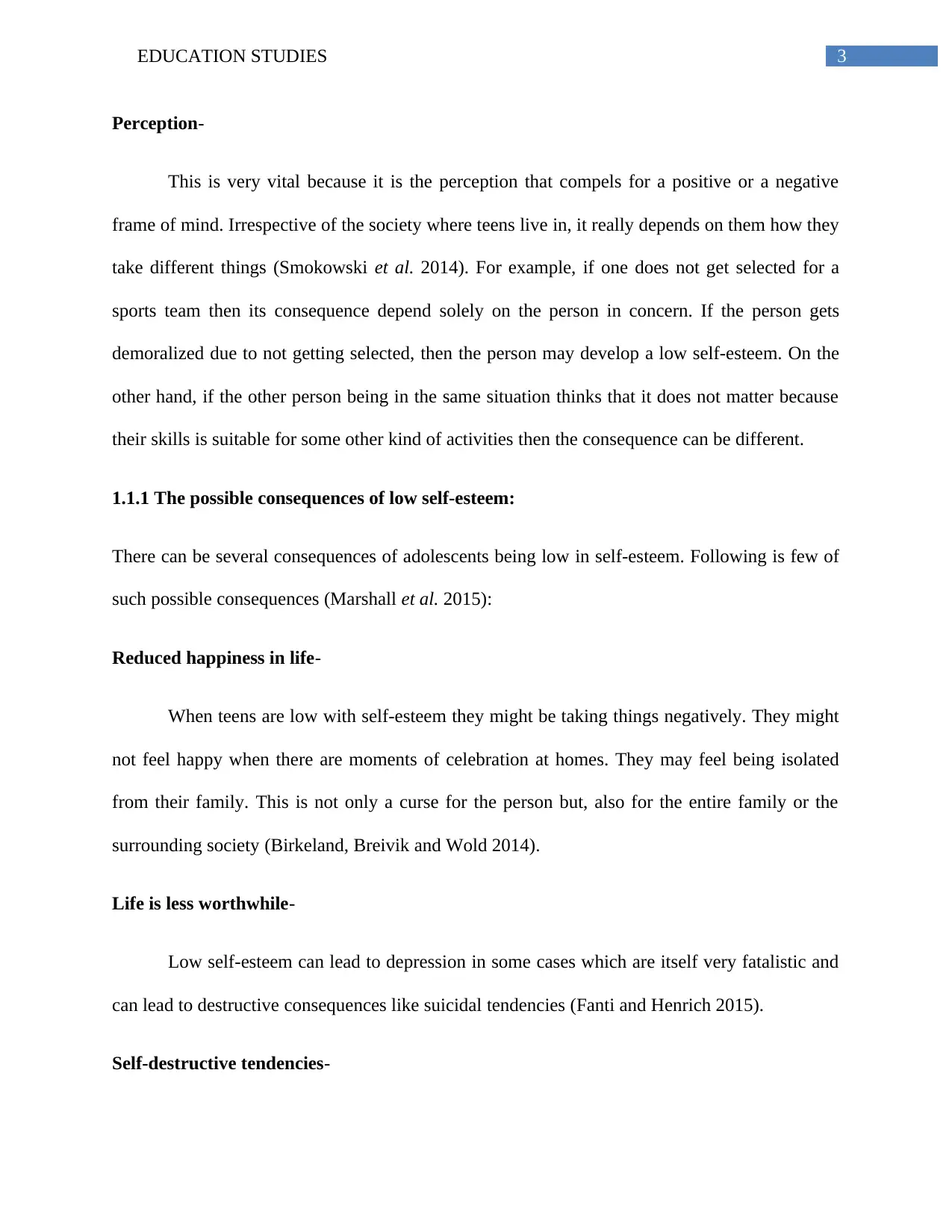
3EDUCATION STUDIES
Perception-
This is very vital because it is the perception that compels for a positive or a negative
frame of mind. Irrespective of the society where teens live in, it really depends on them how they
take different things (Smokowski et al. 2014). For example, if one does not get selected for a
sports team then its consequence depend solely on the person in concern. If the person gets
demoralized due to not getting selected, then the person may develop a low self-esteem. On the
other hand, if the other person being in the same situation thinks that it does not matter because
their skills is suitable for some other kind of activities then the consequence can be different.
1.1.1 The possible consequences of low self-esteem:
There can be several consequences of adolescents being low in self-esteem. Following is few of
such possible consequences (Marshall et al. 2015):
Reduced happiness in life-
When teens are low with self-esteem they might be taking things negatively. They might
not feel happy when there are moments of celebration at homes. They may feel being isolated
from their family. This is not only a curse for the person but, also for the entire family or the
surrounding society (Birkeland, Breivik and Wold 2014).
Life is less worthwhile-
Low self-esteem can lead to depression in some cases which are itself very fatalistic and
can lead to destructive consequences like suicidal tendencies (Fanti and Henrich 2015).
Self-destructive tendencies-
Perception-
This is very vital because it is the perception that compels for a positive or a negative
frame of mind. Irrespective of the society where teens live in, it really depends on them how they
take different things (Smokowski et al. 2014). For example, if one does not get selected for a
sports team then its consequence depend solely on the person in concern. If the person gets
demoralized due to not getting selected, then the person may develop a low self-esteem. On the
other hand, if the other person being in the same situation thinks that it does not matter because
their skills is suitable for some other kind of activities then the consequence can be different.
1.1.1 The possible consequences of low self-esteem:
There can be several consequences of adolescents being low in self-esteem. Following is few of
such possible consequences (Marshall et al. 2015):
Reduced happiness in life-
When teens are low with self-esteem they might be taking things negatively. They might
not feel happy when there are moments of celebration at homes. They may feel being isolated
from their family. This is not only a curse for the person but, also for the entire family or the
surrounding society (Birkeland, Breivik and Wold 2014).
Life is less worthwhile-
Low self-esteem can lead to depression in some cases which are itself very fatalistic and
can lead to destructive consequences like suicidal tendencies (Fanti and Henrich 2015).
Self-destructive tendencies-
Paraphrase This Document
Need a fresh take? Get an instant paraphrase of this document with our AI Paraphraser
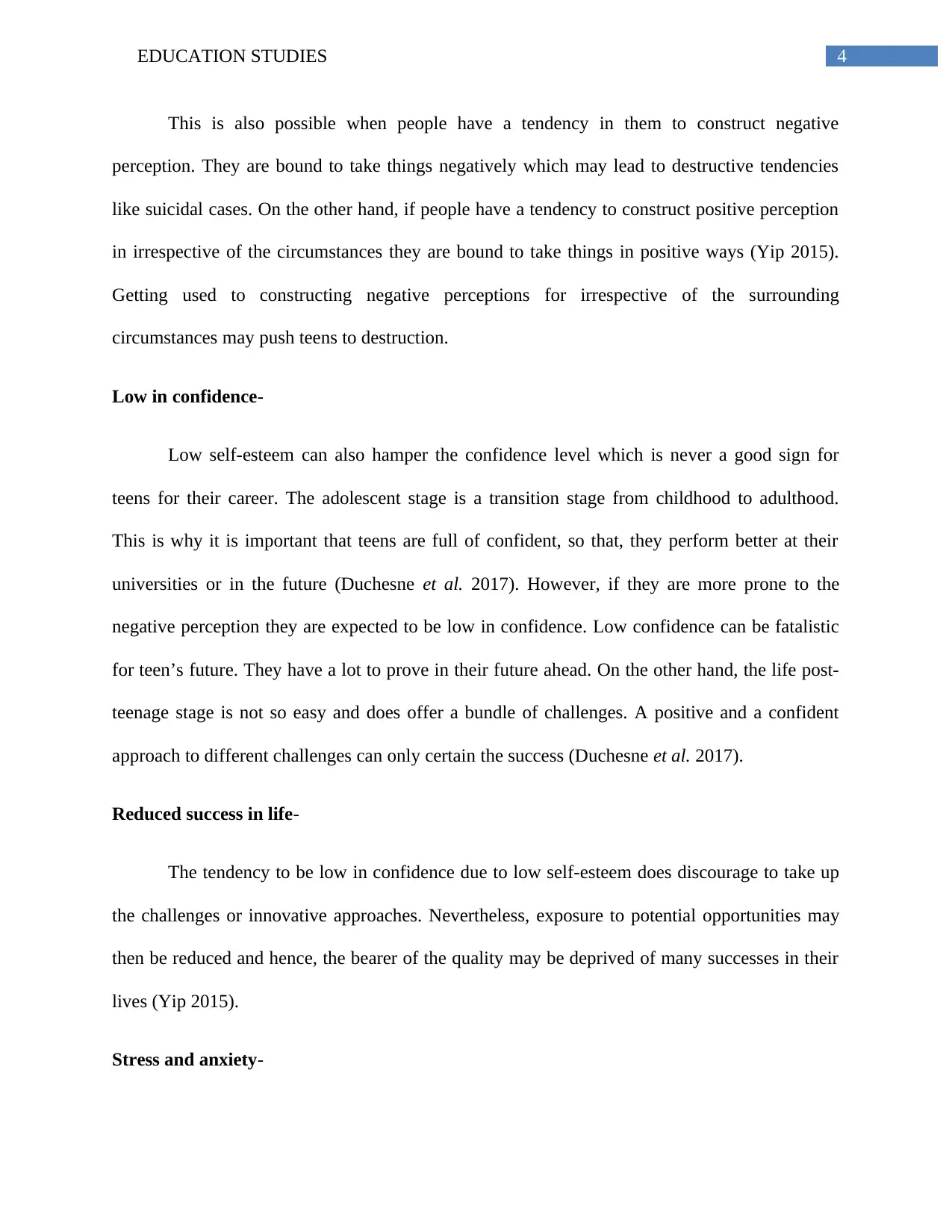
4EDUCATION STUDIES
This is also possible when people have a tendency in them to construct negative
perception. They are bound to take things negatively which may lead to destructive tendencies
like suicidal cases. On the other hand, if people have a tendency to construct positive perception
in irrespective of the circumstances they are bound to take things in positive ways (Yip 2015).
Getting used to constructing negative perceptions for irrespective of the surrounding
circumstances may push teens to destruction.
Low in confidence-
Low self-esteem can also hamper the confidence level which is never a good sign for
teens for their career. The adolescent stage is a transition stage from childhood to adulthood.
This is why it is important that teens are full of confident, so that, they perform better at their
universities or in the future (Duchesne et al. 2017). However, if they are more prone to the
negative perception they are expected to be low in confidence. Low confidence can be fatalistic
for teen’s future. They have a lot to prove in their future ahead. On the other hand, the life post-
teenage stage is not so easy and does offer a bundle of challenges. A positive and a confident
approach to different challenges can only certain the success (Duchesne et al. 2017).
Reduced success in life-
The tendency to be low in confidence due to low self-esteem does discourage to take up
the challenges or innovative approaches. Nevertheless, exposure to potential opportunities may
then be reduced and hence, the bearer of the quality may be deprived of many successes in their
lives (Yip 2015).
Stress and anxiety-
This is also possible when people have a tendency in them to construct negative
perception. They are bound to take things negatively which may lead to destructive tendencies
like suicidal cases. On the other hand, if people have a tendency to construct positive perception
in irrespective of the circumstances they are bound to take things in positive ways (Yip 2015).
Getting used to constructing negative perceptions for irrespective of the surrounding
circumstances may push teens to destruction.
Low in confidence-
Low self-esteem can also hamper the confidence level which is never a good sign for
teens for their career. The adolescent stage is a transition stage from childhood to adulthood.
This is why it is important that teens are full of confident, so that, they perform better at their
universities or in the future (Duchesne et al. 2017). However, if they are more prone to the
negative perception they are expected to be low in confidence. Low confidence can be fatalistic
for teen’s future. They have a lot to prove in their future ahead. On the other hand, the life post-
teenage stage is not so easy and does offer a bundle of challenges. A positive and a confident
approach to different challenges can only certain the success (Duchesne et al. 2017).
Reduced success in life-
The tendency to be low in confidence due to low self-esteem does discourage to take up
the challenges or innovative approaches. Nevertheless, exposure to potential opportunities may
then be reduced and hence, the bearer of the quality may be deprived of many successes in their
lives (Yip 2015).
Stress and anxiety-
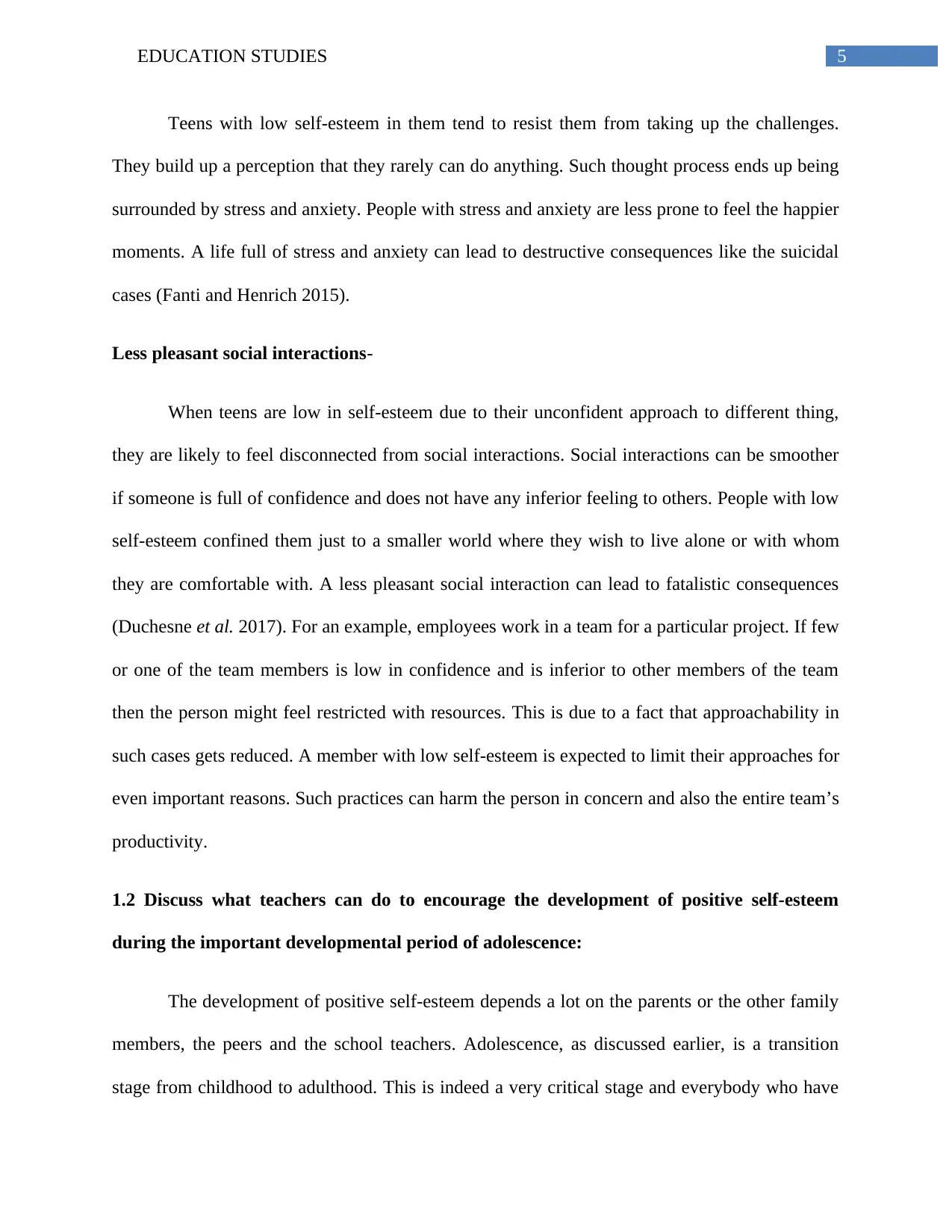
5EDUCATION STUDIES
Teens with low self-esteem in them tend to resist them from taking up the challenges.
They build up a perception that they rarely can do anything. Such thought process ends up being
surrounded by stress and anxiety. People with stress and anxiety are less prone to feel the happier
moments. A life full of stress and anxiety can lead to destructive consequences like the suicidal
cases (Fanti and Henrich 2015).
Less pleasant social interactions-
When teens are low in self-esteem due to their unconfident approach to different thing,
they are likely to feel disconnected from social interactions. Social interactions can be smoother
if someone is full of confidence and does not have any inferior feeling to others. People with low
self-esteem confined them just to a smaller world where they wish to live alone or with whom
they are comfortable with. A less pleasant social interaction can lead to fatalistic consequences
(Duchesne et al. 2017). For an example, employees work in a team for a particular project. If few
or one of the team members is low in confidence and is inferior to other members of the team
then the person might feel restricted with resources. This is due to a fact that approachability in
such cases gets reduced. A member with low self-esteem is expected to limit their approaches for
even important reasons. Such practices can harm the person in concern and also the entire team’s
productivity.
1.2 Discuss what teachers can do to encourage the development of positive self-esteem
during the important developmental period of adolescence:
The development of positive self-esteem depends a lot on the parents or the other family
members, the peers and the school teachers. Adolescence, as discussed earlier, is a transition
stage from childhood to adulthood. This is indeed a very critical stage and everybody who have
Teens with low self-esteem in them tend to resist them from taking up the challenges.
They build up a perception that they rarely can do anything. Such thought process ends up being
surrounded by stress and anxiety. People with stress and anxiety are less prone to feel the happier
moments. A life full of stress and anxiety can lead to destructive consequences like the suicidal
cases (Fanti and Henrich 2015).
Less pleasant social interactions-
When teens are low in self-esteem due to their unconfident approach to different thing,
they are likely to feel disconnected from social interactions. Social interactions can be smoother
if someone is full of confidence and does not have any inferior feeling to others. People with low
self-esteem confined them just to a smaller world where they wish to live alone or with whom
they are comfortable with. A less pleasant social interaction can lead to fatalistic consequences
(Duchesne et al. 2017). For an example, employees work in a team for a particular project. If few
or one of the team members is low in confidence and is inferior to other members of the team
then the person might feel restricted with resources. This is due to a fact that approachability in
such cases gets reduced. A member with low self-esteem is expected to limit their approaches for
even important reasons. Such practices can harm the person in concern and also the entire team’s
productivity.
1.2 Discuss what teachers can do to encourage the development of positive self-esteem
during the important developmental period of adolescence:
The development of positive self-esteem depends a lot on the parents or the other family
members, the peers and the school teachers. Adolescence, as discussed earlier, is a transition
stage from childhood to adulthood. This is indeed a very critical stage and everybody who have
⊘ This is a preview!⊘
Do you want full access?
Subscribe today to unlock all pages.

Trusted by 1+ million students worldwide
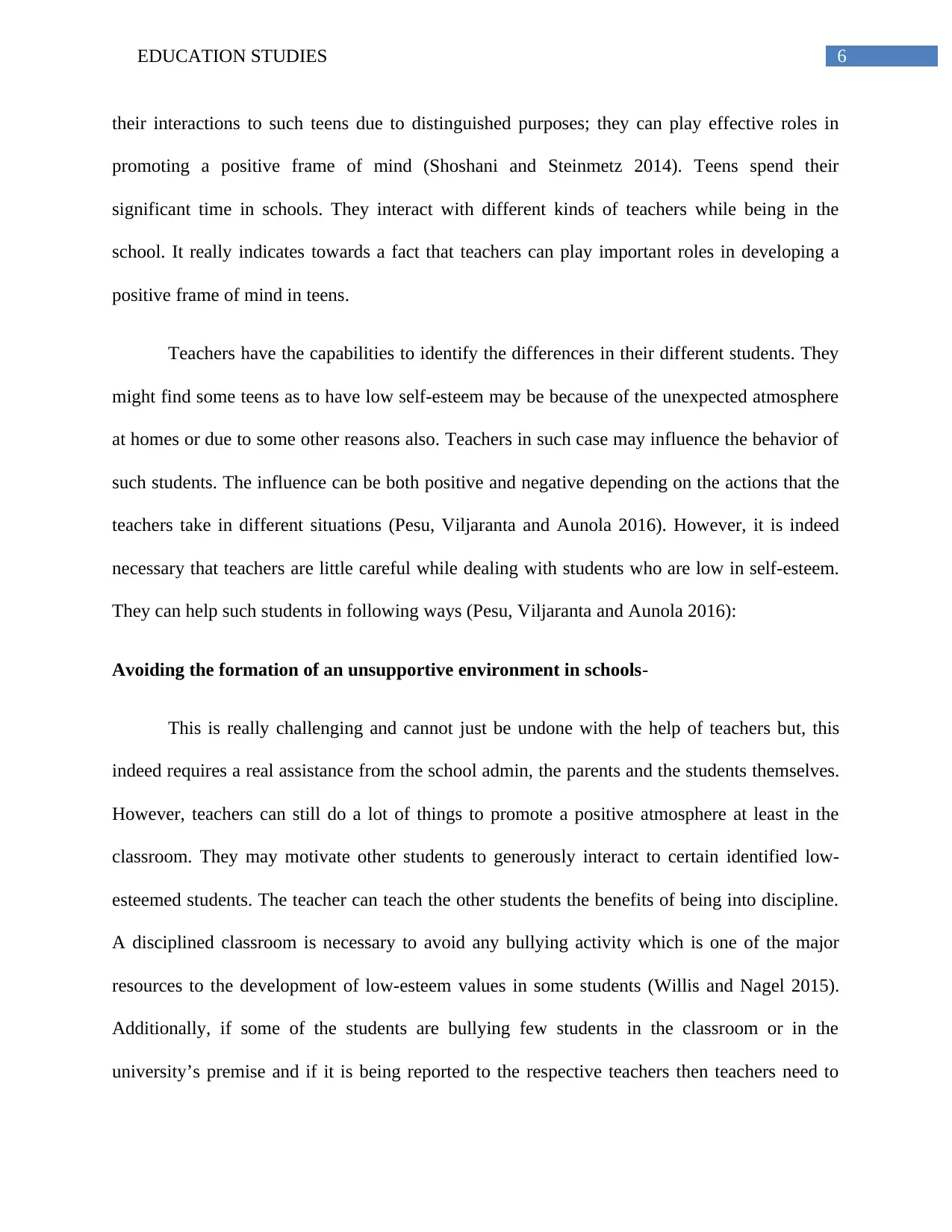
6EDUCATION STUDIES
their interactions to such teens due to distinguished purposes; they can play effective roles in
promoting a positive frame of mind (Shoshani and Steinmetz 2014). Teens spend their
significant time in schools. They interact with different kinds of teachers while being in the
school. It really indicates towards a fact that teachers can play important roles in developing a
positive frame of mind in teens.
Teachers have the capabilities to identify the differences in their different students. They
might find some teens as to have low self-esteem may be because of the unexpected atmosphere
at homes or due to some other reasons also. Teachers in such case may influence the behavior of
such students. The influence can be both positive and negative depending on the actions that the
teachers take in different situations (Pesu, Viljaranta and Aunola 2016). However, it is indeed
necessary that teachers are little careful while dealing with students who are low in self-esteem.
They can help such students in following ways (Pesu, Viljaranta and Aunola 2016):
Avoiding the formation of an unsupportive environment in schools-
This is really challenging and cannot just be undone with the help of teachers but, this
indeed requires a real assistance from the school admin, the parents and the students themselves.
However, teachers can still do a lot of things to promote a positive atmosphere at least in the
classroom. They may motivate other students to generously interact to certain identified low-
esteemed students. The teacher can teach the other students the benefits of being into discipline.
A disciplined classroom is necessary to avoid any bullying activity which is one of the major
resources to the development of low-esteem values in some students (Willis and Nagel 2015).
Additionally, if some of the students are bullying few students in the classroom or in the
university’s premise and if it is being reported to the respective teachers then teachers need to
their interactions to such teens due to distinguished purposes; they can play effective roles in
promoting a positive frame of mind (Shoshani and Steinmetz 2014). Teens spend their
significant time in schools. They interact with different kinds of teachers while being in the
school. It really indicates towards a fact that teachers can play important roles in developing a
positive frame of mind in teens.
Teachers have the capabilities to identify the differences in their different students. They
might find some teens as to have low self-esteem may be because of the unexpected atmosphere
at homes or due to some other reasons also. Teachers in such case may influence the behavior of
such students. The influence can be both positive and negative depending on the actions that the
teachers take in different situations (Pesu, Viljaranta and Aunola 2016). However, it is indeed
necessary that teachers are little careful while dealing with students who are low in self-esteem.
They can help such students in following ways (Pesu, Viljaranta and Aunola 2016):
Avoiding the formation of an unsupportive environment in schools-
This is really challenging and cannot just be undone with the help of teachers but, this
indeed requires a real assistance from the school admin, the parents and the students themselves.
However, teachers can still do a lot of things to promote a positive atmosphere at least in the
classroom. They may motivate other students to generously interact to certain identified low-
esteemed students. The teacher can teach the other students the benefits of being into discipline.
A disciplined classroom is necessary to avoid any bullying activity which is one of the major
resources to the development of low-esteem values in some students (Willis and Nagel 2015).
Additionally, if some of the students are bullying few students in the classroom or in the
university’s premise and if it is being reported to the respective teachers then teachers need to
Paraphrase This Document
Need a fresh take? Get an instant paraphrase of this document with our AI Paraphraser
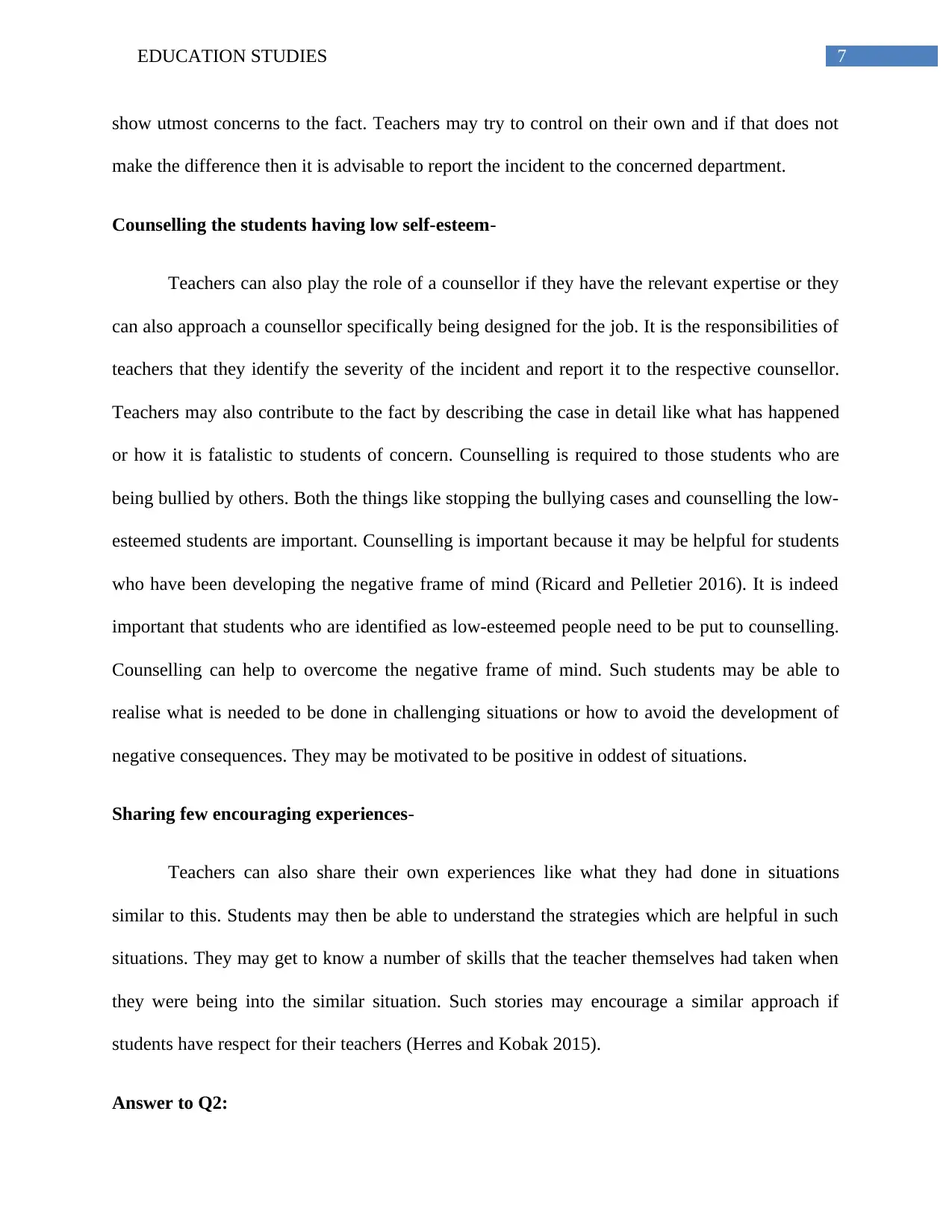
7EDUCATION STUDIES
show utmost concerns to the fact. Teachers may try to control on their own and if that does not
make the difference then it is advisable to report the incident to the concerned department.
Counselling the students having low self-esteem-
Teachers can also play the role of a counsellor if they have the relevant expertise or they
can also approach a counsellor specifically being designed for the job. It is the responsibilities of
teachers that they identify the severity of the incident and report it to the respective counsellor.
Teachers may also contribute to the fact by describing the case in detail like what has happened
or how it is fatalistic to students of concern. Counselling is required to those students who are
being bullied by others. Both the things like stopping the bullying cases and counselling the low-
esteemed students are important. Counselling is important because it may be helpful for students
who have been developing the negative frame of mind (Ricard and Pelletier 2016). It is indeed
important that students who are identified as low-esteemed people need to be put to counselling.
Counselling can help to overcome the negative frame of mind. Such students may be able to
realise what is needed to be done in challenging situations or how to avoid the development of
negative consequences. They may be motivated to be positive in oddest of situations.
Sharing few encouraging experiences-
Teachers can also share their own experiences like what they had done in situations
similar to this. Students may then be able to understand the strategies which are helpful in such
situations. They may get to know a number of skills that the teacher themselves had taken when
they were being into the similar situation. Such stories may encourage a similar approach if
students have respect for their teachers (Herres and Kobak 2015).
Answer to Q2:
show utmost concerns to the fact. Teachers may try to control on their own and if that does not
make the difference then it is advisable to report the incident to the concerned department.
Counselling the students having low self-esteem-
Teachers can also play the role of a counsellor if they have the relevant expertise or they
can also approach a counsellor specifically being designed for the job. It is the responsibilities of
teachers that they identify the severity of the incident and report it to the respective counsellor.
Teachers may also contribute to the fact by describing the case in detail like what has happened
or how it is fatalistic to students of concern. Counselling is required to those students who are
being bullied by others. Both the things like stopping the bullying cases and counselling the low-
esteemed students are important. Counselling is important because it may be helpful for students
who have been developing the negative frame of mind (Ricard and Pelletier 2016). It is indeed
important that students who are identified as low-esteemed people need to be put to counselling.
Counselling can help to overcome the negative frame of mind. Such students may be able to
realise what is needed to be done in challenging situations or how to avoid the development of
negative consequences. They may be motivated to be positive in oddest of situations.
Sharing few encouraging experiences-
Teachers can also share their own experiences like what they had done in situations
similar to this. Students may then be able to understand the strategies which are helpful in such
situations. They may get to know a number of skills that the teacher themselves had taken when
they were being into the similar situation. Such stories may encourage a similar approach if
students have respect for their teachers (Herres and Kobak 2015).
Answer to Q2:
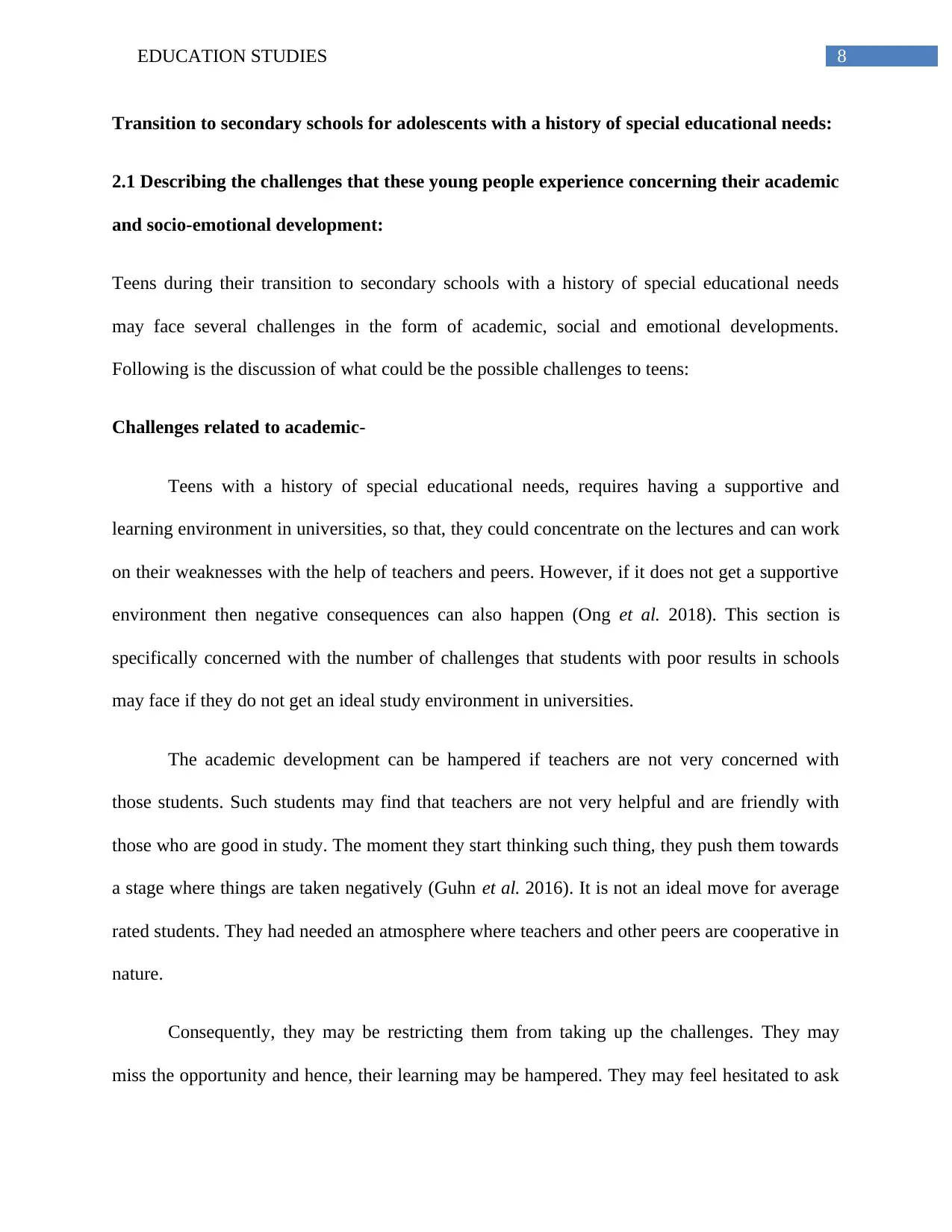
8EDUCATION STUDIES
Transition to secondary schools for adolescents with a history of special educational needs:
2.1 Describing the challenges that these young people experience concerning their academic
and socio-emotional development:
Teens during their transition to secondary schools with a history of special educational needs
may face several challenges in the form of academic, social and emotional developments.
Following is the discussion of what could be the possible challenges to teens:
Challenges related to academic-
Teens with a history of special educational needs, requires having a supportive and
learning environment in universities, so that, they could concentrate on the lectures and can work
on their weaknesses with the help of teachers and peers. However, if it does not get a supportive
environment then negative consequences can also happen (Ong et al. 2018). This section is
specifically concerned with the number of challenges that students with poor results in schools
may face if they do not get an ideal study environment in universities.
The academic development can be hampered if teachers are not very concerned with
those students. Such students may find that teachers are not very helpful and are friendly with
those who are good in study. The moment they start thinking such thing, they push them towards
a stage where things are taken negatively (Guhn et al. 2016). It is not an ideal move for average
rated students. They had needed an atmosphere where teachers and other peers are cooperative in
nature.
Consequently, they may be restricting them from taking up the challenges. They may
miss the opportunity and hence, their learning may be hampered. They may feel hesitated to ask
Transition to secondary schools for adolescents with a history of special educational needs:
2.1 Describing the challenges that these young people experience concerning their academic
and socio-emotional development:
Teens during their transition to secondary schools with a history of special educational needs
may face several challenges in the form of academic, social and emotional developments.
Following is the discussion of what could be the possible challenges to teens:
Challenges related to academic-
Teens with a history of special educational needs, requires having a supportive and
learning environment in universities, so that, they could concentrate on the lectures and can work
on their weaknesses with the help of teachers and peers. However, if it does not get a supportive
environment then negative consequences can also happen (Ong et al. 2018). This section is
specifically concerned with the number of challenges that students with poor results in schools
may face if they do not get an ideal study environment in universities.
The academic development can be hampered if teachers are not very concerned with
those students. Such students may find that teachers are not very helpful and are friendly with
those who are good in study. The moment they start thinking such thing, they push them towards
a stage where things are taken negatively (Guhn et al. 2016). It is not an ideal move for average
rated students. They had needed an atmosphere where teachers and other peers are cooperative in
nature.
Consequently, they may be restricting them from taking up the challenges. They may
miss the opportunity and hence, their learning may be hampered. They may feel hesitated to ask
⊘ This is a preview!⊘
Do you want full access?
Subscribe today to unlock all pages.

Trusted by 1+ million students worldwide
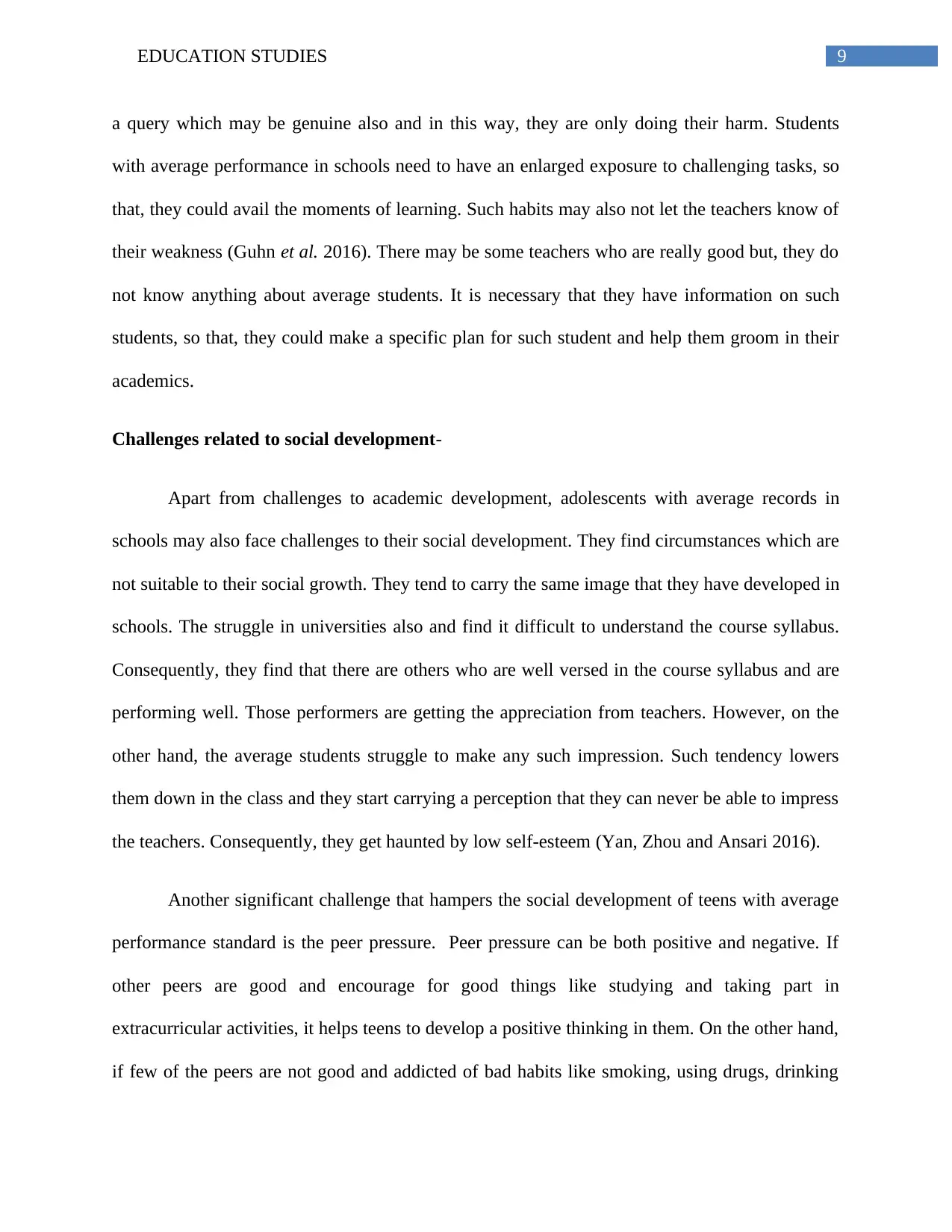
9EDUCATION STUDIES
a query which may be genuine also and in this way, they are only doing their harm. Students
with average performance in schools need to have an enlarged exposure to challenging tasks, so
that, they could avail the moments of learning. Such habits may also not let the teachers know of
their weakness (Guhn et al. 2016). There may be some teachers who are really good but, they do
not know anything about average students. It is necessary that they have information on such
students, so that, they could make a specific plan for such student and help them groom in their
academics.
Challenges related to social development-
Apart from challenges to academic development, adolescents with average records in
schools may also face challenges to their social development. They find circumstances which are
not suitable to their social growth. They tend to carry the same image that they have developed in
schools. The struggle in universities also and find it difficult to understand the course syllabus.
Consequently, they find that there are others who are well versed in the course syllabus and are
performing well. Those performers are getting the appreciation from teachers. However, on the
other hand, the average students struggle to make any such impression. Such tendency lowers
them down in the class and they start carrying a perception that they can never be able to impress
the teachers. Consequently, they get haunted by low self-esteem (Yan, Zhou and Ansari 2016).
Another significant challenge that hampers the social development of teens with average
performance standard is the peer pressure. Peer pressure can be both positive and negative. If
other peers are good and encourage for good things like studying and taking part in
extracurricular activities, it helps teens to develop a positive thinking in them. On the other hand,
if few of the peers are not good and addicted of bad habits like smoking, using drugs, drinking
a query which may be genuine also and in this way, they are only doing their harm. Students
with average performance in schools need to have an enlarged exposure to challenging tasks, so
that, they could avail the moments of learning. Such habits may also not let the teachers know of
their weakness (Guhn et al. 2016). There may be some teachers who are really good but, they do
not know anything about average students. It is necessary that they have information on such
students, so that, they could make a specific plan for such student and help them groom in their
academics.
Challenges related to social development-
Apart from challenges to academic development, adolescents with average records in
schools may also face challenges to their social development. They find circumstances which are
not suitable to their social growth. They tend to carry the same image that they have developed in
schools. The struggle in universities also and find it difficult to understand the course syllabus.
Consequently, they find that there are others who are well versed in the course syllabus and are
performing well. Those performers are getting the appreciation from teachers. However, on the
other hand, the average students struggle to make any such impression. Such tendency lowers
them down in the class and they start carrying a perception that they can never be able to impress
the teachers. Consequently, they get haunted by low self-esteem (Yan, Zhou and Ansari 2016).
Another significant challenge that hampers the social development of teens with average
performance standard is the peer pressure. Peer pressure can be both positive and negative. If
other peers are good and encourage for good things like studying and taking part in
extracurricular activities, it helps teens to develop a positive thinking in them. On the other hand,
if few of the peers are not good and addicted of bad habits like smoking, using drugs, drinking
Paraphrase This Document
Need a fresh take? Get an instant paraphrase of this document with our AI Paraphraser
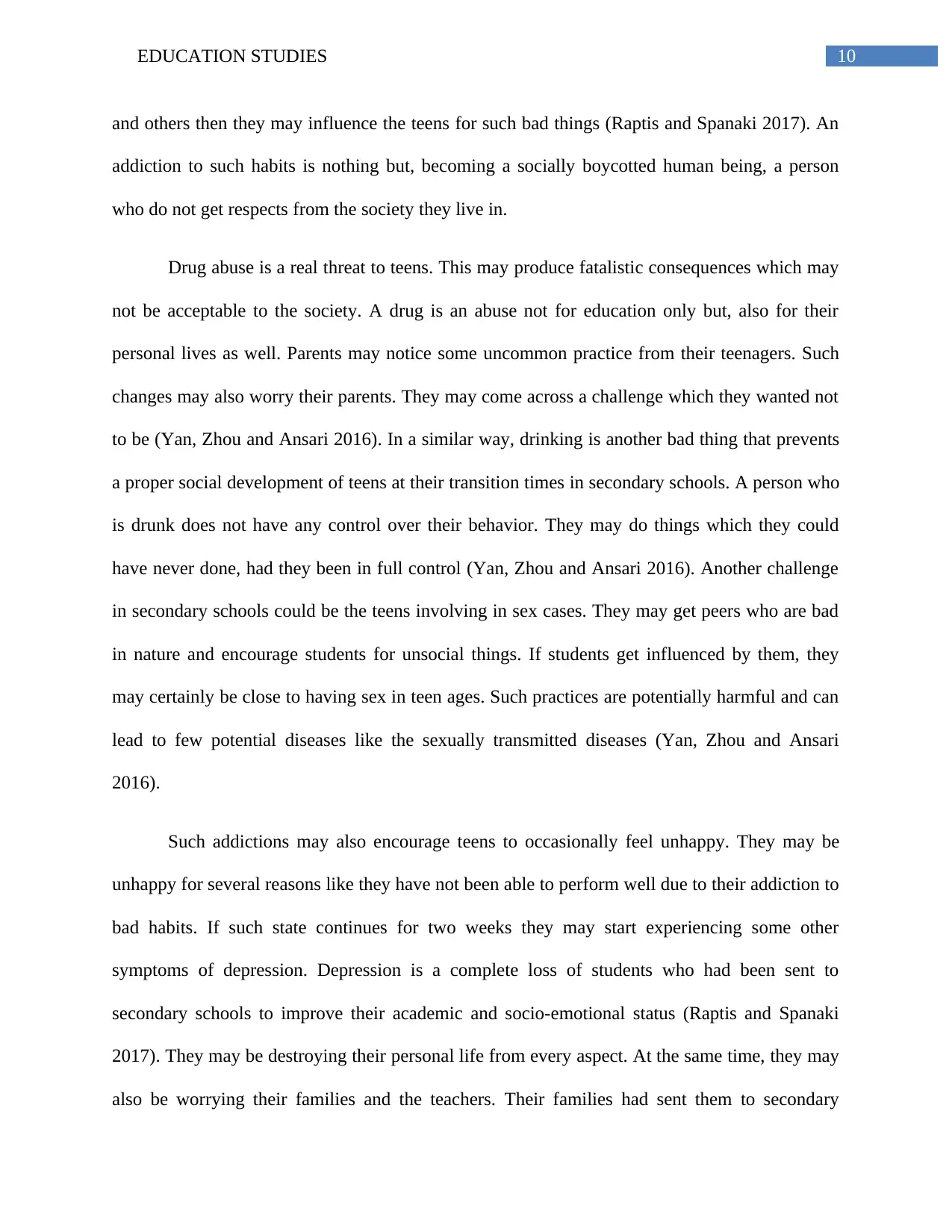
10EDUCATION STUDIES
and others then they may influence the teens for such bad things (Raptis and Spanaki 2017). An
addiction to such habits is nothing but, becoming a socially boycotted human being, a person
who do not get respects from the society they live in.
Drug abuse is a real threat to teens. This may produce fatalistic consequences which may
not be acceptable to the society. A drug is an abuse not for education only but, also for their
personal lives as well. Parents may notice some uncommon practice from their teenagers. Such
changes may also worry their parents. They may come across a challenge which they wanted not
to be (Yan, Zhou and Ansari 2016). In a similar way, drinking is another bad thing that prevents
a proper social development of teens at their transition times in secondary schools. A person who
is drunk does not have any control over their behavior. They may do things which they could
have never done, had they been in full control (Yan, Zhou and Ansari 2016). Another challenge
in secondary schools could be the teens involving in sex cases. They may get peers who are bad
in nature and encourage students for unsocial things. If students get influenced by them, they
may certainly be close to having sex in teen ages. Such practices are potentially harmful and can
lead to few potential diseases like the sexually transmitted diseases (Yan, Zhou and Ansari
2016).
Such addictions may also encourage teens to occasionally feel unhappy. They may be
unhappy for several reasons like they have not been able to perform well due to their addiction to
bad habits. If such state continues for two weeks they may start experiencing some other
symptoms of depression. Depression is a complete loss of students who had been sent to
secondary schools to improve their academic and socio-emotional status (Raptis and Spanaki
2017). They may be destroying their personal life from every aspect. At the same time, they may
also be worrying their families and the teachers. Their families had sent them to secondary
and others then they may influence the teens for such bad things (Raptis and Spanaki 2017). An
addiction to such habits is nothing but, becoming a socially boycotted human being, a person
who do not get respects from the society they live in.
Drug abuse is a real threat to teens. This may produce fatalistic consequences which may
not be acceptable to the society. A drug is an abuse not for education only but, also for their
personal lives as well. Parents may notice some uncommon practice from their teenagers. Such
changes may also worry their parents. They may come across a challenge which they wanted not
to be (Yan, Zhou and Ansari 2016). In a similar way, drinking is another bad thing that prevents
a proper social development of teens at their transition times in secondary schools. A person who
is drunk does not have any control over their behavior. They may do things which they could
have never done, had they been in full control (Yan, Zhou and Ansari 2016). Another challenge
in secondary schools could be the teens involving in sex cases. They may get peers who are bad
in nature and encourage students for unsocial things. If students get influenced by them, they
may certainly be close to having sex in teen ages. Such practices are potentially harmful and can
lead to few potential diseases like the sexually transmitted diseases (Yan, Zhou and Ansari
2016).
Such addictions may also encourage teens to occasionally feel unhappy. They may be
unhappy for several reasons like they have not been able to perform well due to their addiction to
bad habits. If such state continues for two weeks they may start experiencing some other
symptoms of depression. Depression is a complete loss of students who had been sent to
secondary schools to improve their academic and socio-emotional status (Raptis and Spanaki
2017). They may be destroying their personal life from every aspect. At the same time, they may
also be worrying their families and the teachers. Their families had sent them to secondary
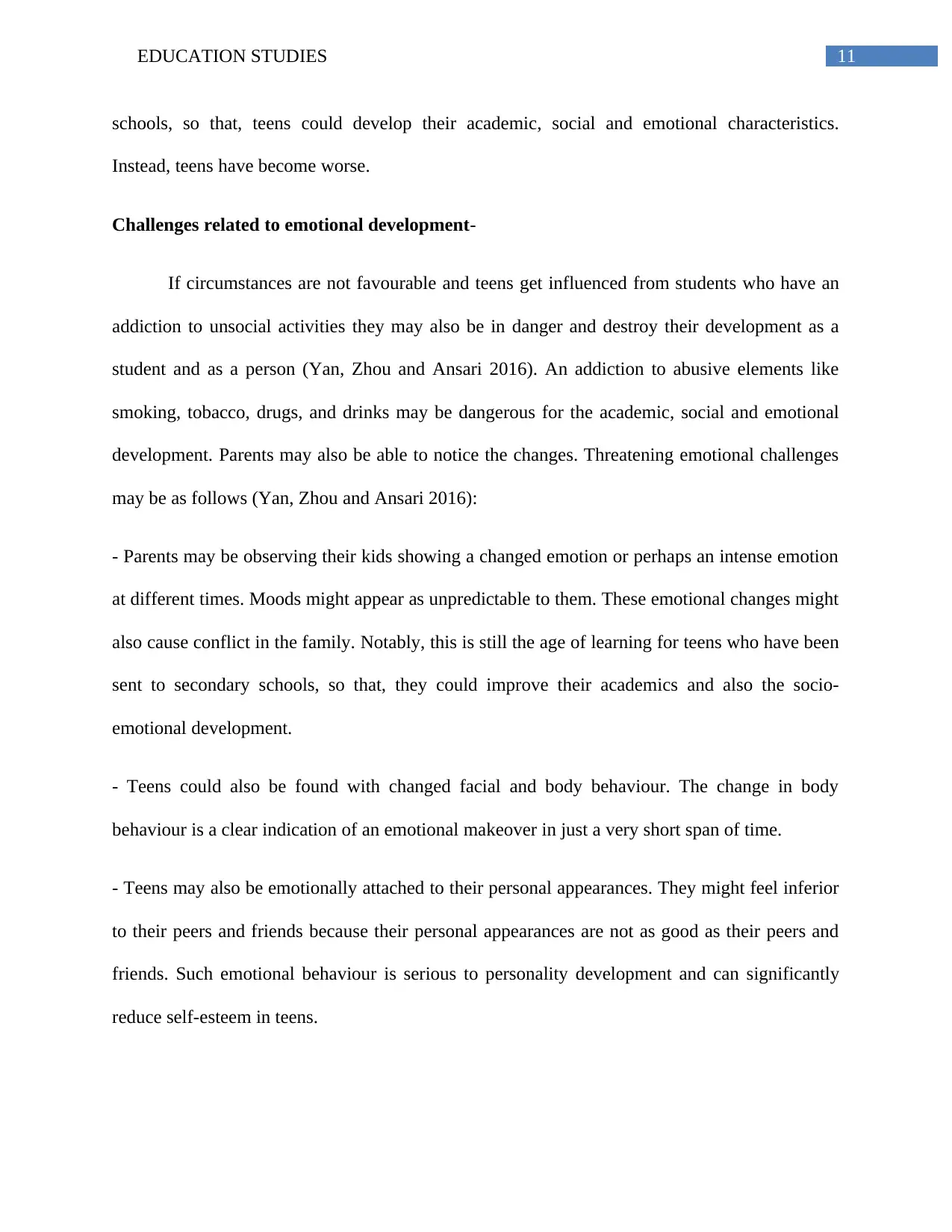
11EDUCATION STUDIES
schools, so that, teens could develop their academic, social and emotional characteristics.
Instead, teens have become worse.
Challenges related to emotional development-
If circumstances are not favourable and teens get influenced from students who have an
addiction to unsocial activities they may also be in danger and destroy their development as a
student and as a person (Yan, Zhou and Ansari 2016). An addiction to abusive elements like
smoking, tobacco, drugs, and drinks may be dangerous for the academic, social and emotional
development. Parents may also be able to notice the changes. Threatening emotional challenges
may be as follows (Yan, Zhou and Ansari 2016):
- Parents may be observing their kids showing a changed emotion or perhaps an intense emotion
at different times. Moods might appear as unpredictable to them. These emotional changes might
also cause conflict in the family. Notably, this is still the age of learning for teens who have been
sent to secondary schools, so that, they could improve their academics and also the socio-
emotional development.
- Teens could also be found with changed facial and body behaviour. The change in body
behaviour is a clear indication of an emotional makeover in just a very short span of time.
- Teens may also be emotionally attached to their personal appearances. They might feel inferior
to their peers and friends because their personal appearances are not as good as their peers and
friends. Such emotional behaviour is serious to personality development and can significantly
reduce self-esteem in teens.
schools, so that, teens could develop their academic, social and emotional characteristics.
Instead, teens have become worse.
Challenges related to emotional development-
If circumstances are not favourable and teens get influenced from students who have an
addiction to unsocial activities they may also be in danger and destroy their development as a
student and as a person (Yan, Zhou and Ansari 2016). An addiction to abusive elements like
smoking, tobacco, drugs, and drinks may be dangerous for the academic, social and emotional
development. Parents may also be able to notice the changes. Threatening emotional challenges
may be as follows (Yan, Zhou and Ansari 2016):
- Parents may be observing their kids showing a changed emotion or perhaps an intense emotion
at different times. Moods might appear as unpredictable to them. These emotional changes might
also cause conflict in the family. Notably, this is still the age of learning for teens who have been
sent to secondary schools, so that, they could improve their academics and also the socio-
emotional development.
- Teens could also be found with changed facial and body behaviour. The change in body
behaviour is a clear indication of an emotional makeover in just a very short span of time.
- Teens may also be emotionally attached to their personal appearances. They might feel inferior
to their peers and friends because their personal appearances are not as good as their peers and
friends. Such emotional behaviour is serious to personality development and can significantly
reduce self-esteem in teens.
⊘ This is a preview!⊘
Do you want full access?
Subscribe today to unlock all pages.

Trusted by 1+ million students worldwide
1 out of 19
Related Documents
Your All-in-One AI-Powered Toolkit for Academic Success.
+13062052269
info@desklib.com
Available 24*7 on WhatsApp / Email
![[object Object]](/_next/static/media/star-bottom.7253800d.svg)
Unlock your academic potential
Copyright © 2020–2025 A2Z Services. All Rights Reserved. Developed and managed by ZUCOL.





